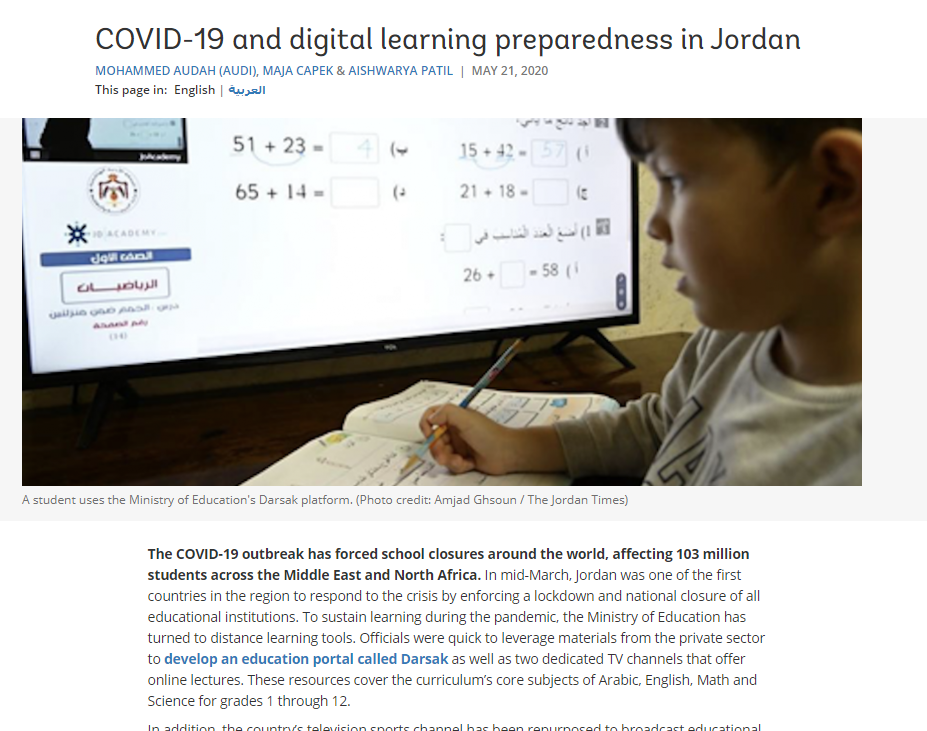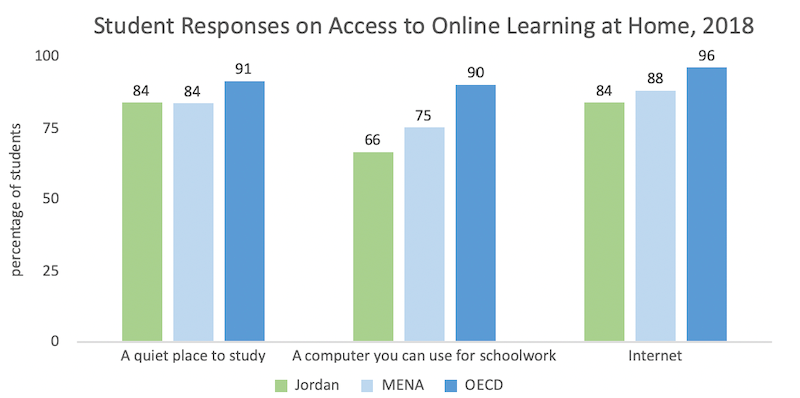Jordan Arab Voices: COVID-19 and digital learning preparedness in Jordan
date:2020-06-03 20:12author:小编source:Arab Voicesviews:

The COVID-19 outbreak has forced school closures around the world, affecting 103 million students across the Middle East and North Africa. In mid-March, Jordan was one of the first countries in the region to respond to the crisis by enforcing a lockdown and national closure of all educational institutions. To sustain learning during the pandemic, the Ministry of Education has turned to distance learning tools. Officials were quick to leverage materials from the private sector to develop an education portal called Darsak as well as two dedicated TV channels that offer online lectures. These resources cover the curriculum’s core subjects of Arabic, English, Math and Science for grades 1 through 12.
In addition, the country’s television sports channel has been repurposed to broadcast educational material tailored to students preparing for Tawjihi, the secondary school leaving examination. The Ministry of Education also supported teaching staff by rolling out new interventions to make it easier to transition to distance learning. Not wanting to leave anyone behind, Prime Minister Dr. Omar Razzaz urged parents to get involved in the government’s efforts to ensure success in distance learning. These timely measures are helping contain and mitigate the impact of the outbreak on learning in Jordan.
The next step is for the ministry to carefully consider reach and quality. Earlier pandemic outbreaks such as the Ebola crisis showed that school closures can lead to learning losses that disproportionately impact vulnerable populations. They also highlighted the importance of effectively using distance learning tools while promoting equitable access to minimize the impact of disruptions. An analysis gives us an idea of Jordan’s preparedness for widescale digital learning along three key dimensions of the “digital gap”: (1) Access to digital devices and the internet, (2) Use of online resources, and (3) School and teacher preparedness to leverage digital solutions for learning.
In addition, the country’s television sports channel has been repurposed to broadcast educational material tailored to students preparing for Tawjihi, the secondary school leaving examination. The Ministry of Education also supported teaching staff by rolling out new interventions to make it easier to transition to distance learning. Not wanting to leave anyone behind, Prime Minister Dr. Omar Razzaz urged parents to get involved in the government’s efforts to ensure success in distance learning. These timely measures are helping contain and mitigate the impact of the outbreak on learning in Jordan.
The next step is for the ministry to carefully consider reach and quality. Earlier pandemic outbreaks such as the Ebola crisis showed that school closures can lead to learning losses that disproportionately impact vulnerable populations. They also highlighted the importance of effectively using distance learning tools while promoting equitable access to minimize the impact of disruptions. An analysis gives us an idea of Jordan’s preparedness for widescale digital learning along three key dimensions of the “digital gap”: (1) Access to digital devices and the internet, (2) Use of online resources, and (3) School and teacher preparedness to leverage digital solutions for learning.

We need more data on digital usage. Results from PISA suggest that students with internet access make use of online resources, with 94% of students reporting using the internet for reading emails, research, participating in online discussion, and messaging. Access is necessary but not sufficient for effective distance learning and must be complemented by a supporting enabling environment, both within the system and in the development of key competencies among students and teachers. Going forward, a careful assessment of the skills covered by online resources is needed, and an understanding of how best to transmit these skills to students. Without clear guidelines, engagement with online content is daunting and less learning-oriented, especially among communities who might not have the digital skills to make the best use of the tools developed by the Ministry of Education.
In Jordan, many children have access, but universal access has not yet been achieved. Over 16% of students in Jordan lack internet access, 16 percentage points below the OECD average, while one-third do not have a computer that can be used for schoolwork, 25 percentage points below the OECD benchmark. Looking in more detail, this digital gap is found mostly in low-income households: less than 30% of students from the lowest economic status groups have a computer for schoolwork, and only about 50% can access the internet.
There are model examples of Jordanian schools ready to transition to online learning, but more can be done. Schools play a critical role in monitoring and promoting student engagement with digital learning materials. PISA results reveal that most schools in Jordan are not well prepared to continue classes virtually and provide individualized student support. Only 43% of 15-year-old students in Jordan attend schools with an effective online learning support platform. In addition, less than half of schools have professional resources for teachers to capitalize on digital material, substantially below the Middle East and North Africa average of 72%. Results further suggest that most teachers lack the necessary technical and pedagogical skills to integrate digital resources into their instruction. Connecting physical and online resources is of paramount importance, as it creates an ecosystem that incentivizes skill development in utilizing EdTech solutions.
The World Bank and the Ministry of Education’s response to the pandemic has been swift. As part of its ongoing support to the Jordanian education system, the World Bank is helping the government ensure that all children can effectively leverage distance-learning opportunities.
Source:https://blogs.worldbank.org/arabvoices/covid-19-and-digital-learning-preparedness-jordan
In Jordan, many children have access, but universal access has not yet been achieved. Over 16% of students in Jordan lack internet access, 16 percentage points below the OECD average, while one-third do not have a computer that can be used for schoolwork, 25 percentage points below the OECD benchmark. Looking in more detail, this digital gap is found mostly in low-income households: less than 30% of students from the lowest economic status groups have a computer for schoolwork, and only about 50% can access the internet.
There are model examples of Jordanian schools ready to transition to online learning, but more can be done. Schools play a critical role in monitoring and promoting student engagement with digital learning materials. PISA results reveal that most schools in Jordan are not well prepared to continue classes virtually and provide individualized student support. Only 43% of 15-year-old students in Jordan attend schools with an effective online learning support platform. In addition, less than half of schools have professional resources for teachers to capitalize on digital material, substantially below the Middle East and North Africa average of 72%. Results further suggest that most teachers lack the necessary technical and pedagogical skills to integrate digital resources into their instruction. Connecting physical and online resources is of paramount importance, as it creates an ecosystem that incentivizes skill development in utilizing EdTech solutions.
The World Bank and the Ministry of Education’s response to the pandemic has been swift. As part of its ongoing support to the Jordanian education system, the World Bank is helping the government ensure that all children can effectively leverage distance-learning opportunities.
Source:https://blogs.worldbank.org/arabvoices/covid-19-and-digital-learning-preparedness-jordan

